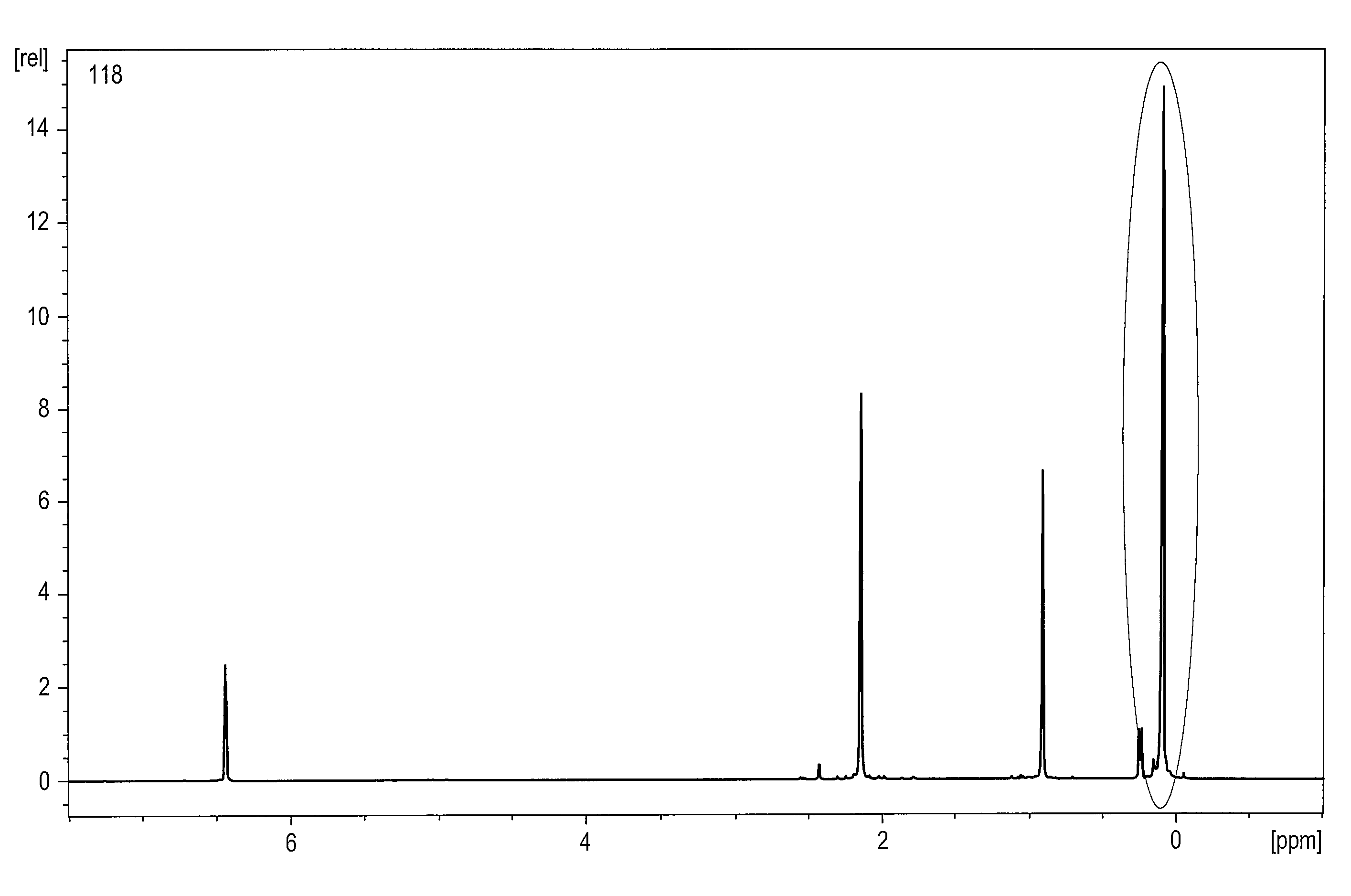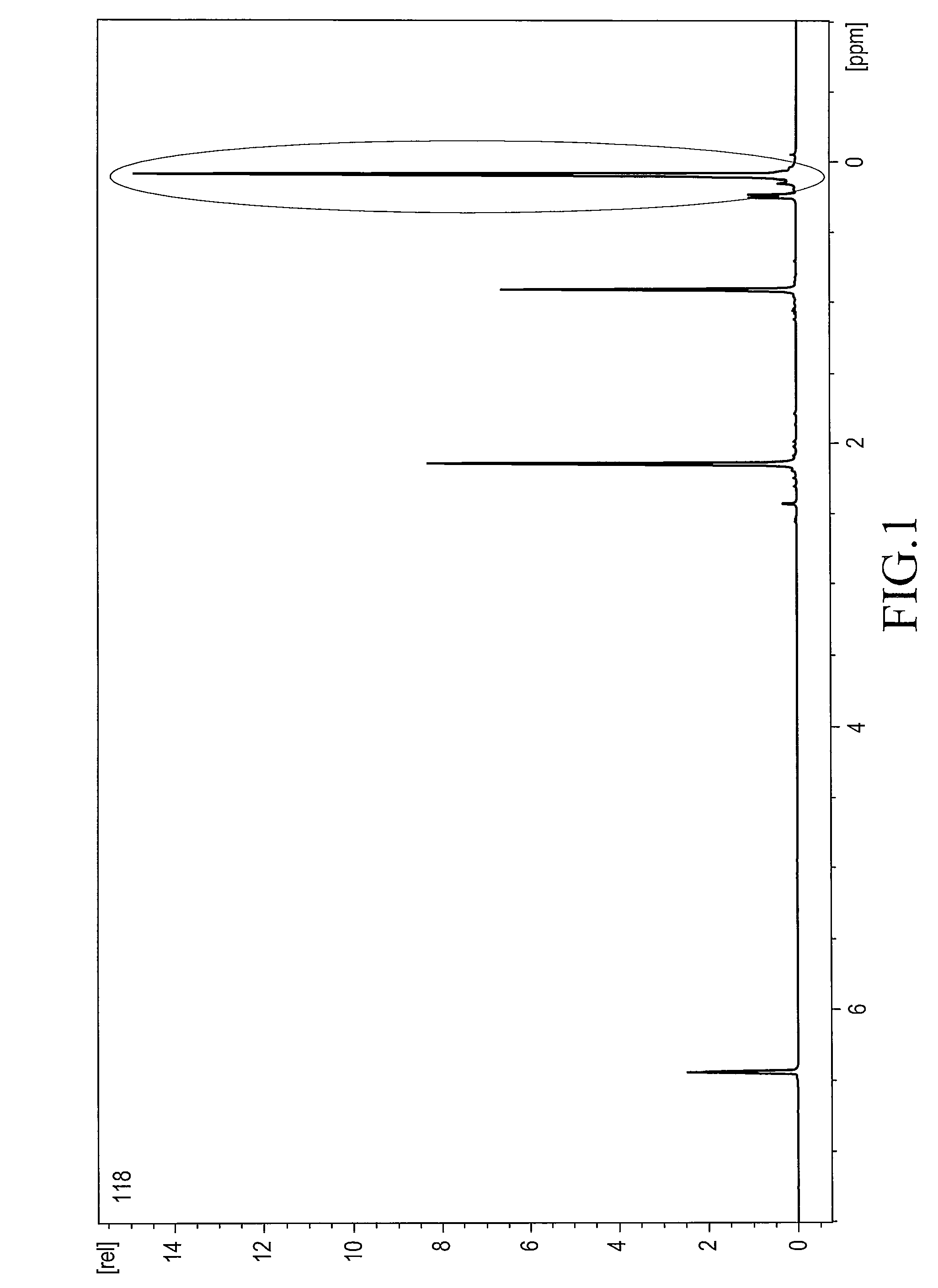Method of preparing 1-methylcyclopropene and applying the same to plants
a technology of methylcyclopropene and plant, applied in the direction of biocide, organic chemistry, hydrocarbon preparation catalysts, etc., can solve the problems of harm to plants as well as human beings, and disadvantageous discharge of fluorotrimethylsilane and 1-mcp
- Summary
- Abstract
- Description
- Claims
- Application Information
AI Technical Summary
Benefits of technology
Problems solved by technology
Method used
Image
Examples
example 1
Synthesis of 1-methyl-1-(methanesulfonyloxy)-2-(dimethylethylsilyl)cyclopropane
(1) Synthesis of 1-methyl-1-hydroxy-2-(dimethylethylsilyl)cyclopropane
[0068]47.3 g (0.17 mole) of titanium (IV) isopropoxide and 19 g (0.17 mole) of dimethylethylvinylsilane were placed in a 500 ml three-neck round bottom flask cooled to −78° C., and 0.34 mole of an isopropylmagnesium chloride Grignard solution was gradually added thereto for 2 hours. The reaction solution thus obtained was warmed to −50° C. and then vigorously stirred for 2 hours. 14.7 g (0.17 mole) of ethyl acetate was gradually added over 30 min, while the reaction solution was maintained at −50° C. The reaction solution was warmed to −20° C., vigorously stirred for 1 hour, warmed to 0° C., and then vigorously stirred for another 1 hour. Finally, the reaction solution was warmed to room temperature and 60 mL of saturated brine was added to the solution. The resulting solution was filtered through Celite which was then thoroughly washed...
example 2
Synthesis of 1-methyl-1-(methanesulfonyloxy)-2-(dimethylpropylsilyl)cyclopropane
(1) Synthesis of 1-methyl-1-hydroxy-2-(dimethylpropylsilyl)cyclopropane
[0082]1-methyl-1-hydroxy-2-(dimethylpropylsilyl)cyclopropane was obtained as a mixture of trans and cis isomers (yield: 52%) using dimethylpropylvinylsilane in the same manner as in Example 1 (1).
[0083]Results of 1H-NMR and 13C-NMR for the trans isomer of the mixture are given below.
[0084]1H-NMR (CDCl3, δ): 2.078 (1H, b, —OH), 1.446 (3H, s), 1.374 (2H, m), 0.971 (1H, m), 0.962 (3H, t), 0.529 (2H, m), 0.376 (1H, dd), 0.044 (1H, dd), −0.019 (3H, s), −0.047 (3H, s).
[0085]13C-NMR (CDCl3, δ): 56.315, 23.670, 18.758, 18.346, 18.282, 17.395, 13.366, −2.675, −2.934.
[0086]Results of 1H-NMR and 13C-NMR for the cis isomer of the mixture are given below.
[0087]1H-NMR (CDCl3, δ): 1.667 (1H, b, —OH), 1.474 (3H, s), 1.371 (2H, m), 0.962 (3H, t), 0.72˜0.65 (2H, m), 0.58˜0.54 (2H, m), 0.007 (3H, s), 0.000 (3H, s), −0.316 (1H, dd).
[0088]13C-NMR (CDCl3, ...
example 3
Synthesis of 1-methyl-1-(methanesulfonyloxy)-2-dimethylbutylsilyl)cyclopropane
(1) Synthesis of 1-methyl-1-hydroxy-2-(dimethylbutylsilyl)cyclopropane
[0096]1-methyl-1-hydroxy-2-(dimethylbutylsilyl)cyclopropane was obtained as a trans isomer, a cis isomer or a trans / cis isomer mixture (yield: 54%) using dimethylbutylvinylsilane in the same manner as in Example 1 (1).
[0097]Results of 1H-NMR 13C-NMR for the trans isomer of the mixture are given below.
[0098]1H-NMR (CDCl3, δ): 2.896 (1H, s, —OH), 1.413 (3H, s), 1.303 (4H, m), 0.945 (1H, dd), 0.863 (3H, t), 0.506 (2H, m), 0.337 (1H, dd), 0.004 (1H, dd), −0.036 (3H, s), −0.069 (3H, s).
[0099]13C-NMR (CDCl3, δ): 56.044, 26.545, 26.078, 23.597, 18.107, 15.773, 13.754, 13.070, −2.737, −3.026.
[0100]Results of 1H-NMR and 13C-NMR for the cis isomer of the mixture are given below.
[0101]1H-NMR (CDCl3, δ): 1.63 (1H, b, —OH), 1.459 (3H, s), 1.38-1.25 (4H, m), 0.865 (3H, t), 0.72˜0.65 (2H, m), 0.59˜0.54 (2H, m), 0.011 (3H, s), 0.003 (3H, s), −0.327 (1H,...
PUM
| Property | Measurement | Unit |
|---|---|---|
| temperature | aaaaa | aaaaa |
| temperature | aaaaa | aaaaa |
| boiling point | aaaaa | aaaaa |
Abstract
Description
Claims
Application Information
 Login to View More
Login to View More - R&D
- Intellectual Property
- Life Sciences
- Materials
- Tech Scout
- Unparalleled Data Quality
- Higher Quality Content
- 60% Fewer Hallucinations
Browse by: Latest US Patents, China's latest patents, Technical Efficacy Thesaurus, Application Domain, Technology Topic, Popular Technical Reports.
© 2025 PatSnap. All rights reserved.Legal|Privacy policy|Modern Slavery Act Transparency Statement|Sitemap|About US| Contact US: help@patsnap.com



